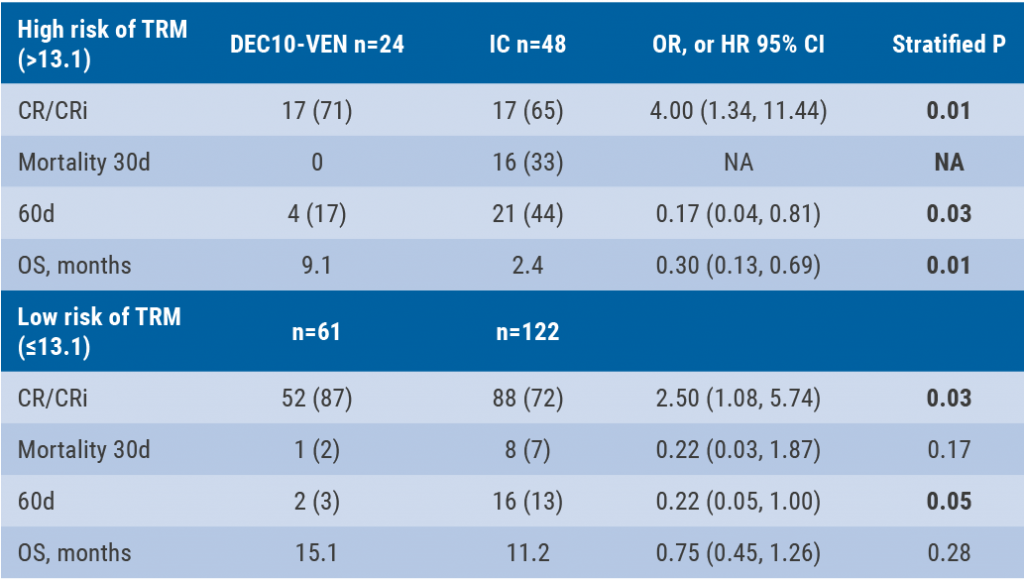Older adults diagnosed with AML who are ineligible for intensive treatment often receive lower-intensity therapies, such as azacitidine or decitabine, which only provide an expected median survival of 9-10 months and complete remission (CR) / CR with incomplete bone marrow recovery (CRi) rates <40%.
Dr Courtney Di Nardo (MD Anderson Cancer Centre, USA) presented the results of the VIALE-A study, which evaluated the efficacy of a combination regimen of azacitidine and venetoclax in older treatment-naïve AML patients (n=431) who were ineligible for intensive therapy [1]. The co-primary endpoints were overall survival (OS) and percentage of participants with CR with or without CRi. Patients were randomised in a 2:1 ratio to the combination regimen or to azacitidine plus placebo.
With a median follow-up of 20.5 months, both primary endpoints were met. The combination of azacitidine and venetoclax led to improved OS (14.7 vs 9.6 months; HR 0.66; 95% CI 0.52-0.85; P<0.001), and improved response rates CR/CRi (66% vs 28%; P<0.001), compared with azacitidine alone. Furthermore, responses were quicker; the median time to first CR/CRi response was 1.3 and 2.8 months, respectively. The duration of CR/CRi was 17.5 months and 13.4 months, respectively. There was also a higher rate of transfusion independence in the azacitidine with venetoclax arm (60% vs 35%). The benefit of venetoclax combined with azacitidine was observed across all key subgroups.
The safety profile included cytopenias, and in particular neutropenia/febrile neutropenia. Dr Di Nardo recommended waiting until the end of cycle 1 to determine whether dose delay or modifications are required. In conclusion, the results from this study demonstrated that, compared with azacitidine and placebo, patients receiving azacitidine and venetoclax as standard induction therapy had improved OS, better rates of CR and composite remission, faster time to first remission, improved duration of remission, and higher rates of transfusion independence. Collectively, these data confirm azacitidine and venetoclax as a new standard of care.
- Di Nardo C et al. VIALE-A: A Randomized, Double-blind, Placebo-Controlled Study of Venetoclax with Azacitidine vs Azacitidine in Treatment-naïve Patients with Acute Myeloid Leukaemia Ineligible for Intensive Chemotherapy. EHA25 Virtual, 11-21 June 2020, Abstract LB2601.
Posted on
Previous Article
« OS benefit in VIALE-C trial Next Article
Precision medicine for poor-prognosis paediatric patients »
« OS benefit in VIALE-C trial Next Article
Precision medicine for poor-prognosis paediatric patients »
Table of Contents: EHA 2020
Featured articles
Myeloid
VIALE-A: newly diagnosed chemo-ineligible AML
DEC10-VEN superior to intensive chemotherapy in high-risk AML
Magrolimab plus azacitidine: good ORR in MDS/AML
Asciminib monotherapy in Ph+ CML: major molecular responses
CML TKI interruption: Swedish registry results
Patients with lower-risk MDS benefit from imetelstat
Better outcomes adding enasidenib to azacitidine in mIDH2-AML
Lymphoid
PET-stratification can omit radiotherapy in early-stage unfavourable Hodgkin lymphoma
Pembrolizumab improves PFS for relapsed/refractory Hodgkin lymphoma
Promising first-in-human trial of epcoritamab in B-NHL
Two trials: acalabrutinib in CLL
Zanubrutinib versus ibrutinib in Waldenström macroglobulinaemia
Deep responses in R/R CLL with venetoclax monotherapy
MRD assessment post-CAR-T predicts ALL allo-HSCT bridging
Plasma Cell Dyscrasias
Daratumumab for light-chain amyloidosis
Isatuximab triplet improves PFS in R/R MM
Initial results from CAR-T cell therapy in MM: KarMMa
Graft-Versus-Host Disease
GRAVITAS-301: improved complete aGVDH response
Ruxolitinib improves steroid-refractory aGVHD across subtypes
Benign Haematology
Paroxysmal nocturnal haemoglobinuria treatment with pegcetacoplan
Mitapivat, a pyruvate kinase-R activator, in SCD is safe with early efficacy results
SCD LentiGlobin gene therapy: new data on VOC and ACS
Paediatric Haematology
Venetoclax + navitoclax promising for R/R ALL or LL
Nivolumab/brentuximab vedotin in R/R HL: good CMR rates
Bench-to-Bedside Science from the Presidential Symposium
Microbiome predicts B-ALL predisposition
Netrin-1 regulates haematopoietic stem cells
Unrecognised role of iron in neutrophil differentiation
Related Articles
September 9, 2020
Zanubrutinib versus ibrutinib in Waldenström macroglobulinaemia
September 9, 2020
VIALE-A: newly diagnosed chemo-ineligible AML

September 9, 2020
DEC10-VEN superior to intensive chemotherapy in high-risk AML
© 2024 Medicom Medical Publishers. All rights reserved. Terms and Conditions | Privacy Policy
HEAD OFFICE
Laarderhoogtweg 25
1101 EB Amsterdam
The Netherlands
T: +31 85 4012 560
E: publishers@medicom-publishers.com

